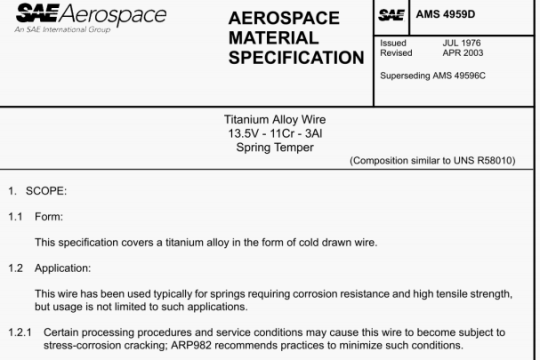SAE AMS 4976F pdf download
SAE AMS 4976F pdf download.Titanium Alloy, Forgings 6.0Al – 2.0Sn – 4.ozr – 2.0 Mo Solution and Precipitation Heat Treated.
1.1 Form:
This specification covers a titanium alloy in the form of forgings and forging stock.
1.2 Application:
These products have been used typically for parts requiring high strength and toughness and good creep resistance up to 1000 F (538 °C), but usage is not limited to such applications.
1.2.1 Certain processing procedures and service conditions may cause these forgings to become subject to stress-corrosion cracking: ARP982 recommends practices to minimize such conditions.
2. APPLICABLE DOCUMENTS:
The issue of the following documents in effect on the date of the purchase order forms a part of this specification to the extent specified herein. The supplier may work to a subsequent revision of a document unless a specific document issue is specified, When the referenced document has been cancelled and no superseding document has been specified, the last published issue of that document shall apply.
2.1 SAE Publications:
Available from SAE. 400 Commonwealth Drive. Warrendale, PA 15096-0001 or www.sae.org.
AMS 2249 Chemical Check Analysis Limits, Titanium and Titanium Alloys
AMS 2750 Pyrometry
AMS 2808 Identification, Forgings
ARP982 Minimizing Stress-Corrosion Cracking in Wrought Titanium Alloy Products
3.2 Melting Pract,ce:
3.2.1 Alloy shall be multiple melted. Melting cycle(s) prior to the final melting cycle shall be made using consumable electrode. nonconsumable electrode, electron beam cold hearth, or plasma arc cold melting practice. The final melting cycle shall be made under vacuum using vacuum arc remelting (VAR) practice with no alloy addition permitted.
3.2.1.1 The atmosphere for nonconsumable electrode melting shall be vacuum or shall be argon and/or helium at an absolute pressure not higher than 1000 mm of mercury.
3.2.1.2 The electrode tip for nonconsumable electrode melting shall be water-cooled copper.
3.3 Condition:
The product shall be supplied in the following condition:
3.31 Forgings: Solution and precipitation heat treated, and descaled.
3.3.2 Forging Stock: As ordered by the forging manufacturer.
3.4 Heat Treatment:
Forgings shall be solution heat treated by heating to a temperature 25 to 50 F (14 to 28 C) degrees below the beta transus determined on each heat of alloy, holding at the selected temperature within ±15 F (±8 °C) for 60 minutes ± 5, and cooling at a rate equivalent to an air cool or faster and peclpitation heat treated by heating to 1100 °F ±15 (593 °C ±8), holding at heat for 8 hours ±0,25, and cooling in air. Pyrometry shall be in accordance with AMS 2750.
3.5 PropertIes:
The product shall conform to the following requirements:
3.5.1 Forgings: Forgings 3.0 inches (76 mm) and under in nominal diameter or least dislance between parallel sides and 9 square inches (58 cni2) and under in cross-sectional area shall conform to the following requirements:
3.5.1.1 Tensile Properties: Shall be as follows, determined on specimens having a gage diameter not less than 0.250 inch (6.35 mm).
3,5.1.2 Room-Temperature Notched Stress-Rupture Properties: A standard cylindrical notched specimen, conforming to ASTM E 292, maintained at room temperature while a load sufficient to produce an initial axial stress of 170 ksi (1172 MPa) is applied continuously, shall not rupture in less than 5 hours. The initial stress may be less than 170 ksi (1172 MPa) and increased to 170 ksi (1172 MPa), based on the initial diameter at root of notch, in increments of 10.0 ksi (69 MPa) at intervals or not less than 5 hours. Test shall be conducted in accordance with ASTM E 292.
3.5.1.3 Creep Properties at 950 F (510 C): An unnotched tensile specimen, maintained at 950 F
±3 (510 °C ±2) while an axial stress of 35.0 ksi (241 MPa) is applied continuously, shall not exceed 0.1% plastic strain in less than 35 hours. Gage dimensions of specimens and techniques used to measure creep shall be as agreed upon by purchaser and vendor. Test shall be conducted in accordance with ASTM E 139.
3.5.1.4 Microstructure: Shall be that structure resulting from processing within the alpha-beta phase field. Microstructure shall conform to 3.5.1.4.1 or 3.5.1.4.2.
3.5.1.4.1 Equiaxed andlor elongated primary alpha in a transformed beta matrix with no continuous network of alpha at prior beta grain boundaries.




